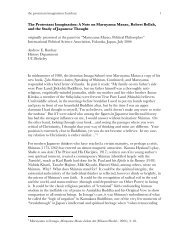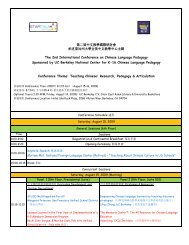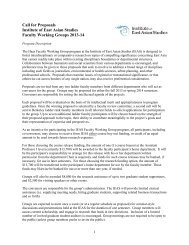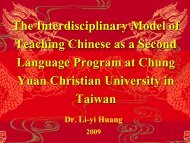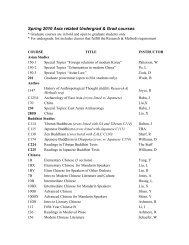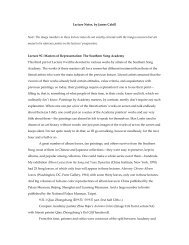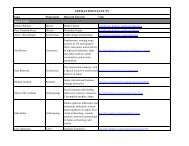Third Edition Spring 2013 - Institute of East Asian Studies, UC ...
Third Edition Spring 2013 - Institute of East Asian Studies, UC ...
Third Edition Spring 2013 - Institute of East Asian Studies, UC ...
You also want an ePaper? Increase the reach of your titles
YUMPU automatically turns print PDFs into web optimized ePapers that Google loves.
thought. 4I will first discuss the Arthashastra’s main ideas, and willthen shift my focus to the all-important topic <strong>of</strong> the Arthashastra’sauthorship. In my discussion <strong>of</strong> the treatise’s ideas and authorship,I will provide background information on the Mauryan Empire andthe political and economic environment <strong>of</strong> northern India at Kautilya’stime. The Arthashastra is a political treatise that is focusedon realpolitik, which refers to a set <strong>of</strong> political and diplomaticstrategies focused on power, practicality, and material gains as opposedto strategies that are based on ideological, moral, and ethicalpremises. Perhaps the best known treatise on realpolitik is NiccolòMachiavelli’s The Prince, and for this reason the Arthashastra has<strong>of</strong>ten been compare to that work. However, scholars <strong>of</strong>ten regardKautilya’s work as even more radical than Machiavelli’s text. Germansociologist Max Weber compares the two texts, stating that“truly radical ‘Machiavellianism’, in the popular sense <strong>of</strong> that word,is classically expressed in Indian literature in the Arthashastra <strong>of</strong>Kautilya (written long before the birth <strong>of</strong> Christ, ostensibly in thetime <strong>of</strong> Chandragupta): compared to it, Machiavelli’s The Princeis harmless.” 5 Weber’s acknowledgment <strong>of</strong> the Arthashastra as anolder and far more radical version <strong>of</strong> Machiavelli’s text has had apr<strong>of</strong>ound impact on its legacy. For now it is important to note thatthe text’s primary focus is on promoting a forceful style <strong>of</strong> politicalpragmatism. However, Kautilya doesn’t just outline harsh strategies;he also provides justification for using them. Roger Boescheclaims that “Although Kautilya proposed an elaborate welfare statein domestic politics … he proved willing to defend the general good<strong>of</strong> this monarchy with harsh measures.” 6 Kautilya only consideredusing extreme tactics if they were employed for the good <strong>of</strong> thestate as a whole. He explains that the primary task <strong>of</strong> a king applyingthe Arthashastra’s strategies is promoting the welfare <strong>of</strong> thepeople. In Book I <strong>of</strong> the Arthashastra he states that for a king “In4 Gautam, P.K. Endogenous Politico-Cultural Resources: Kautilya’s Arthashastraand India’s Strategic Culture5 Eric Matthews, Weber: Selections in Translation, (Cambridge: Cambridge UniversityPress, 1978), 212-225.6 Roger Boesche, “Kautilya’s Arthashastra on War and Diplomacy in AncientIndia,” The Journal <strong>of</strong> Military History, 67, no. 1 (2003): 9-37.the happiness <strong>of</strong> his subjects lies his happiness; in their welfare hiswelfare; whatever pleases himself he shall not consider as good,but whatever pleases his subjects he shall consider as good.” 7 Theideal Kautilyan king exists to promote the welfare <strong>of</strong> his subjects,an idea I will explore in more detail when I apply the Arthashastra’sideas to the corporate world, specifically to the concept <strong>of</strong> value-basedmanagement. Having discussed the Arthashastra’s mainideas, I will now shift my focus to the treatise’s authorship.The text <strong>of</strong> the Arthashastra itself refers to its legendary authorby the name <strong>of</strong> Kautilya; however, Kautilya did not write theArthashastra based solely on his ideas. Instead, Kautilya built uponthe preexisting political and economic ideas present in ancientnorthern India and consolidated them into a single text. WhileKautilya’s predecessors may have independently developed many<strong>of</strong> the Arthashastra’s ideas, Kautilya himself receives the most portion<strong>of</strong> credit for writing the text. This is likely due to the successthat Kautilya had in implementing the Arthashastra’s ideas. Kautilyaand Chandragupta Maurya used the political and economicideas <strong>of</strong> ancient India to build the Mauryan Empire, which wasto become the first pan-Indian empire. Before the advent <strong>of</strong> theMauryan Empire, smaller regional kingdoms dominated the subcontinent.Using the strategies outlined in the Arthashastra, Kautilyaand his king were able to establish an extensive empire in aregion dominated by these smaller kingdoms. Therefore, Kautilyareceived credit for writing the Arthashastra because he was thefirst to successfully use the treatise’s ideas <strong>of</strong> realpolitik to build aand vast state spanning northern India. Kautilya also takes creditfor the Arthashastra’s authorship in part due to the need <strong>of</strong> Indiannationalists to have an iconic figure to place on par with Machiavelliand the other great European political theorists. The practicalnecessity <strong>of</strong> a single individual who could rival great Westernthinkers spurred the recognition <strong>of</strong> Kautilya as the primary author<strong>of</strong> the Arthashastra.Admittedly, Indian nationalists did this largely out <strong>of</strong> convenience,however, and a variety <strong>of</strong> scholars have downplayed Kau-7 Kautilya. Arthashastra. Translated by R. Shamasastry. Bangalore: GovernmentPress, 1915, 1-50.57 Ramanathan Veerappan Kautilya’s Arthashastra 58




